-
Countries
-
Data and Analysis
-
Special Focus
-
Crisis Responses
Displacement Report (IDPs & Returnees)
Country
Title Standard
Libya — IDP and Returnee Report {#} ({DATE})
Operation
Contact
DTM Libya, DTMLibyateam@iom.int
Type
Component
Domain
Confidential

Contact
DTM Libya, DTMLibyateam@iom.int
Language
English
Location
Libya
Snapshot Date
Oct 31 2023
Activity
- Mobility Tracking
- Baseline Assessment
On 10 September 2023 Storm Daniel hit northeastern Libya, leading to substantial rainfall and sudden floods in the coastal areas and cities. The subsequent collapse of the Mansour and Derna dams severely compounded damages across Derna municipality.
As of October 2023, DTM estimates 44,862 IDPs were displaced across Libya due to the flooding. Out of these, Derna municipality hosts the highest number of IDPs, with 23,500 displaced as a result of the floods caused by Storm Daniel.
This dashboard shows the findings on IDP locations and needs for Derna municipality. The findings for all municipalities currently hosting IDPs due to floods can be accessed here: Libya — Impact of Storm Daniel: An Update on Displacement and Needs (November 2023).

Contact
DTM Libya, DTMLibyateam@iom.int
Language
English
Location
Libya
Snapshot Date
Oct 31 2023
Activity
- Mobility Tracking
- Baseline Assessment
This publication presents DTM Libya’s analysis of the displacement situation in north eastern and west Libya following the impacts of Storm Daniel which made landfall in September 2023. The analysis utilizes DTM data collected in October 2023, and estimates that 44,862 persons (8,907 households) have been displaced due to the floods. The majority of IDPs (41,720 IDPs or 93%) are currently located in 18 municipalities across north eastern Libya and the remaining 3,142 IDPs (7%) are in the west. In addition, DTM estimates that 1,715 migrants have also been displaced as a result of the flooding, most of whom (1,690 migrants or 99%) are located in municipalities in north eastern Libya.
Derna municipality hosts the highest number of IDPs, with 23,500 displaced as a result of the floods caused by Storm Daniel. A separate dashboard showing findings on IDP locations and needs for Derna municipality can be accessed here: Libya — Impact of Storm Daniel: Displacement and Needs Update: Derna Municipality.
Contact
DTMLibya@iom.int
Language
English
Location
Libya
Snapshot Date
Sep 23 2023
Activity
- Other
This report provides an overview of the situation and the main needs of the displaced population and the host community in Derna and surrounding areas.
HIGHLIGHTS
- Based on field reports some roads in the affected areas are being reopened although movement between the eastern and western parts of the city continues to be heavily restricted.
- Approximately 1,300 individuals (260 families) remain in their homes in the affected areas of Alajabilh, Abu Mansour, and Maghar, out of fear of being victims of theft due to the lack of electricity in these areas. They are in urgent need of food and non-food items as well as medical assistance. They have not received any aid.
- Throughout Derna, field teams also report severe shortages of medications including those for chronic diseases, as well as a lack of storage and pharmacists.
- Specific needs were identified for individuals with restricted mobility, women, children, infants, adults and elderly.
- Seven collective accommodations were hosting displaced individuals, mostly in schools and hotels. They lacked adequate services and items such as sanitation, security, medication, diapers, baby food, etc.

Contact
DTM Libya, DTMLibyateam@iom.int
Language
English
Location
Libya
Snapshot Date
Aug 24 2023
Activity
- Mobility Tracking
- Baseline Assessment
This publication presents DTM Libya’s Displacement and Solutions Package, which presents the analysis of displacement situation in Libya using Data for Solutions to Internal Displacement (DSID) framework. The analysis utilizes DTM Round 45 data (December 2022) and estimates that out of 125,802 persons identified as displaced 75,643 are on solutions pathways. Furthermore, out of the 705,426 persons previously displaced (IDP returnees) who had returned to their places of origin 616,832 persons are on solutions pathways. Till mid-2023 no new internal displacements have been reported in Libya.
Contact
DTM Libya, DTMLibya@iom.int
Language
English
Location
Libya
Period Covered
Jul 01 2022
Aug 31 2022
Activity
- Mobility Tracking
- Baseline Assessment
This IOM Displacement Tracking Matrix (DTM) report presents the data and findings on internally displaced persons (IDPs) and returnees between July – August 2022, representing Round 43 of the DTM Mobility Tracking in Libya. The trend of return of IDPs to their places of origin and the resulting decrease in the number of people displaced observed since the October 2020 ceasefire has continued. During this round, a total of 695,516 individuals previously displaced were identified to have returned to their places of origin, while 134,787 IDPs were also identified as still displaced by end of August 2022. This accounts for a 57 per cent reduction in the number of people internally displaced in Libya since the October 2020 ceasefire (when 316,415 IDPs were reported).
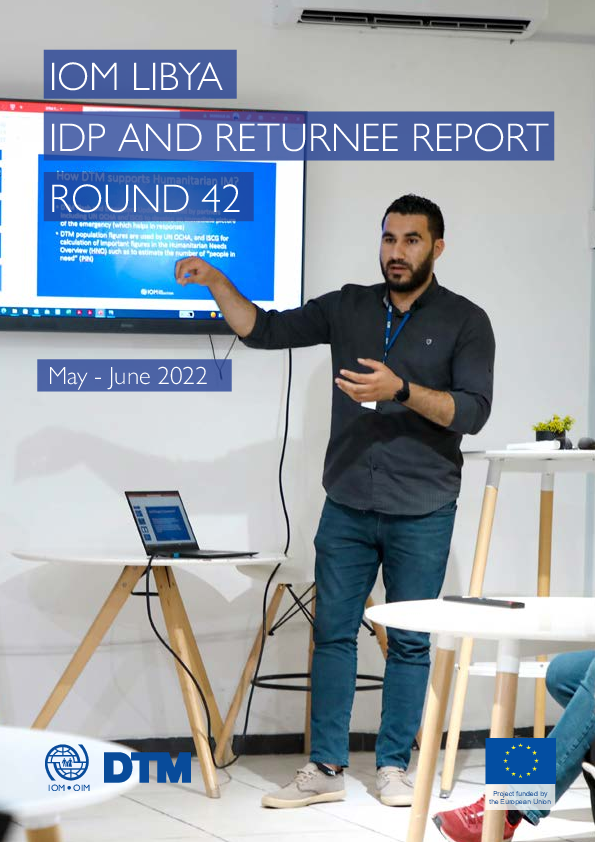
Contact
DTM Libya, DTMLibyateam@iom.int
Language
English
Location
Libya
Period Covered
May 01 2022
Jun 30 2022
Activity
- Mobility Tracking
- Baseline Assessment
This IOM Displacement Tracking Matrix (DTM) report presents the data and findings on internally displaced persons (IDPs) and returnees between May – June 2022, representing round 42 of the DTM Mobility Tracking in Libya. The number of people internally displaced (IDPs) in Libya continued to decrease during the reporting period as 143,419 individuals (29,194 families) were identified to be displaced by June 2022 compared to 159,996 IDPs identified in the previous round. By June 2022, a total of 688,121 individuals previously displaced were reported to have returned to their places of origin in 56 municipalities that had been previously affected by armed conflict or insecurity.
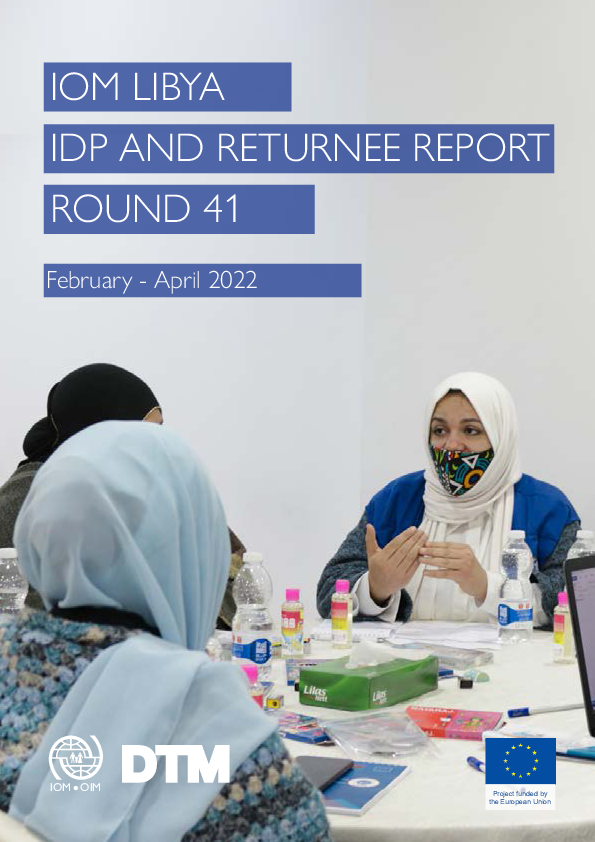
Contact
DTM Libya, DTMLibya@iom.int
Language
English
Location
Libya
Period Covered
Feb 01 2022
Apr 30 2022
Activity
- Mobility Tracking
- Baseline Assessment
This IOM Displacement Tracking Matrix (DTM) report presents the data and findings on internally displaced persons (IDPs) and returnees between February 2021 – April 2022, representing round 41 of the DTM Mobility Tracking in Libya. The trend of return of IDPs to their places of origin and the resulting decrease in the number of people displaced observed since the October 2020 ceasefire continued, with 680,772 individuals previously displaced returned to their places of origin, while 159,996 IDPs still identified as displaced by end of April 2022. This accounts for a 49 per cent reduction in the number of people internally displaced in Libya since the October 2020 ceasefire (when 316,415 IDPs were reported)

Contact
DTM Libya, DTMLibya@iom.int
Language
Arabic
Location
Libya
Period Covered
Oct 01 2021
Nov 30 2021
Activity
- Mobility Tracking
- Baseline Assessment
يعرض هذا التقرير البيانات المجمّعة فيما بين شهري أكتوبر ونوفمبر من سنة 2021 حول النازحين داخليا والعائدين. وتمثّل هذه البيانات والمستخلصات الجولة 39 من تتبع التنقل في ليبيا التي أجرتها مصفوفة تتبع النزوح. ولم يتم الإبلاغ عن أيّة حركات نزوح كبرى منذ شهر يونيو من سنة 2020 وطوال السنة الجارية، فيما تواصل نسق عودة الأسر النازحة مسبقا إلى مناطقها الأصلية. وتماشيا مع التوجه الذي امتد على مدار السنة، استمرّ انخفاض عدد النازحين في ليبيا في هذه الجولة، ورافق ذلك ارتفاع في عدد العائدين. وقد ارتفع عدد العائدين في الجولة 39 ليبلغ 661.892 عائداً في مقارنة بالجولة 38 التي تم فيها تسجيل 648.317 فرداً. ويشير ذلك إلى زيادة طفيفة في نسبة العائدين (بنسبة 2 في المائة) بعد فترة من الاستقرار دامت على مدار الأشهر الستة الأخيرة. وفي أعقاب موجة العودة، تواصل عدد النازحين في الانخفاض في هذه الجولة، ممّا يقدّر بـ 199.949 نازحاً في شهر سبتمبر من سنة 2021 إلى 179.046 نازحاً بنهاية شهر نوفمبر. ويمثّل ذلك انخفاض بما يقارب 21.000 فرداً (بنسبة 10 في المائة) على مدار فترة الدراسة وبالتزامن مع استمرار موجة عودة الأسر النازحة إلى مناطق أصلها.
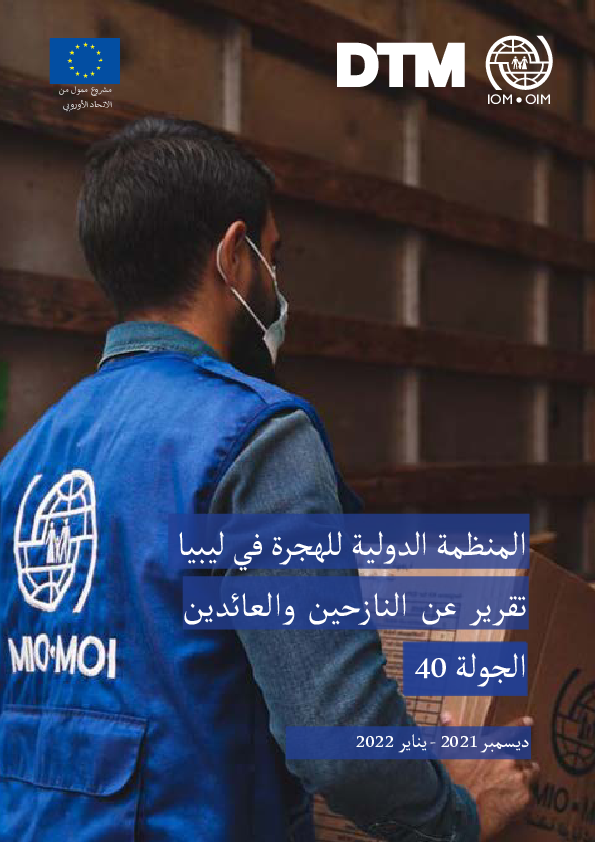
Contact
DTM Libya, DTMLibya@iom.int
Language
Arabic
Location
Libya
Period Covered
Dec 01 2021
Jan 31 2022
Activity
- Mobility Tracking
- Baseline Assessment
يعرض تقرير مصفوفة تتبع النزوح الخاصّة بالمنظمة الدولية للهجرة البيانات والمستخلصات حول النازحين داخليا والعائدين فيما بين شهري ديسمبر من سنة 2021 وشهر يناير من سنة 2022 وفي إطار الجولة 40 من تتبع التنقل في ليبيا. وتماشيا مع التوجّه الذي امتدّ طيلة سنة 2021، تواصل انخفاض عدد النازحين داخليا في البلاد وتزامن ذلك مع ارتفاع في عدد العائدين، إذ بلغ عددهم في الجولة الـ40 673.553 فردا في مقارنة بعدد 661.892 عائدا تم إحصاؤهم في الجولة 39. ويشير ذلك إلى ارتفاع طفيف (بنسبة 2 في المائة)في عدد الأفراد العائدين إلى مناطق أصلهم وإلى ارتفاع بنسبة 19 في المائة عن شهر أكتوبر 2020 الذي شهد وقف إطلاق النار في ليبيا. وقد تواصل انخفاض عدد النازحين في هذه الجولة نتيجة لاستمرار توجّه العودة إلى مناطق الأصل من 179.047 نازحا في شهر نوفمبر من سنة 2021 إلى 168.011 نازحاً مع نهاية شهر يناير من سنة 2022. ويمثّل هذا انخفاضاً بنسبة 47 في المائة في عدد الأفراد النازحين داخليا في ليبيا منذ وقف إطلاق النار في شهر أكتوبر من سنة 2020 (عندما تم إحصاء 316.415 نازحاً).
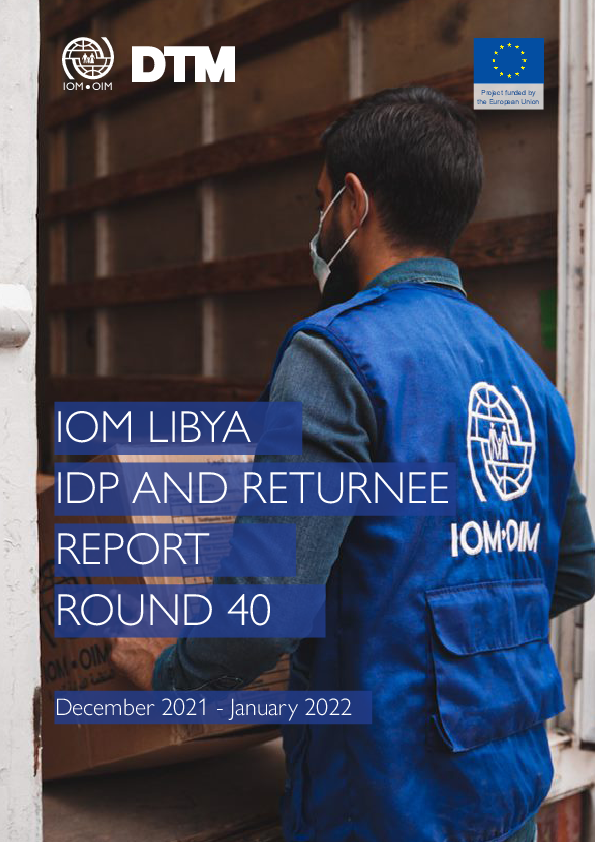
Contact
DTM Libya, DTMLibya@iom.int
Language
English
Location
Libya
Period Covered
Dec 01 2021
Jan 31 2022
Activity
- Mobility Tracking
- Baseline Assessment
This IOM Displacement Tracking Matrix (DTM) report presents the data and findings on internally displaced persons (IDPs) and returnees between December 2021 – January 2022, representing round 40 of the DTM Mobility Tracking in Libya. Consistent with the trend observed throughout 2021, in this round of reporting, the numbers of IDPs within the country continued decreasing, with a parallel increase in the number of returnees. As compared to 661,892 returnees identified in round 39, the number of those identified during round 40 increased to 673,554 individuals. This indicates a slight increase in the percentage of those returning (2%), accounting for a total increase of 19 per cent since October 2020 ceasefire in Libya.
Pagination
- Page 1
- Next page
